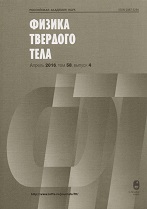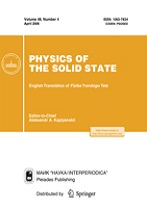|
This article is cited in 4 scientific papers (total in 4 papers)
Dielectrics
Ferroelectric properties of niobium-doped strontium bismuth tantalate films
D. A. Golosova, S. M. Zavadskia, V. V. Kolosb, A. S. Turtsevichb
a Belarussian State University of Computer Science and Radioelectronic Engineering, Minsk, Belarus
b JSC "INTEGRAL", Minsk, Belarus
Abstract:
The characteristics of ferroelectric thin films of strontium bismuth tantalate (SBT) and niobium-doped strontium bismuth tantalate (SBTN) deposited by radio-frequency (RF) magnetron sputtering on Pt/TiO$_{2}$/SiO$_{2}$/Si substrates were investigated. For the formation of the structure of the ferroelectric material, the deposited films were subjected to a subsequent annealing at temperatures of 970–1070 K in an O$_2$ atmosphere. The results of the X-ray diffraction analysis demonstrated that, in contrast to SBT films, in which the Aurivillius phase is formed only at annealing temperatures of 1050–1070 K, the formation of this phase in SBTN films is observed already at a temperature of 970 K. The dependences of the dielectric permittivity, remanent polarization, and coercive force of the SBT and SBTN films on the subsequent annealing conditions were determined. It was found that, upon doping of the SBT films with niobium, the remanent polarization increases by a factor of approximately three, the Curie temperature increases by 50 K, and the dielectric permittivity also increases. It was revealed that, in contrast to the SBT films, the polarization of the SBTN films is observed already at an annealing temperature of approximately 970 K. It was shown that the replacement of SBT films by SBTN films in the manufacture of high-density nonvolatile ferroelectric randomaccess memory (FeRAM) capacitor modules makes it possible to decrease the synthesis temperature from 1070 to 990–1000 K, which improves the compatibility with the planar technology of semiconductor devices. However, it turned out that an increase in the coercive field makes niobium-doped SBT films less attractive for the use in FeRAM.
Keywords:
Dielectric Permittivity, Coercive Force, Ferroelectric Property, Leakage Current Density, Dielectric Loss Tangent.
Received: 07.07.2014
Revised: 25.06.2015
Citation:
D. A. Golosov, S. M. Zavadski, V. V. Kolos, A. S. Turtsevich, “Ferroelectric properties of niobium-doped strontium bismuth tantalate films”, Fizika Tverdogo Tela, 58:1 (2016), 51–55; Phys. Solid State, 58:1 (2016), 50–54
Linking options:
https://www.mathnet.ru/eng/ftt10106 https://www.mathnet.ru/eng/ftt/v58/i1/p51
|


| Statistics & downloads: |
| Abstract page: | 100 | | Full-text PDF : | 47 |
|





 Contact us:
Contact us: Terms of Use
Terms of Use
 Registration to the website
Registration to the website Logotypes
Logotypes








 Citation in format
Citation in format 
